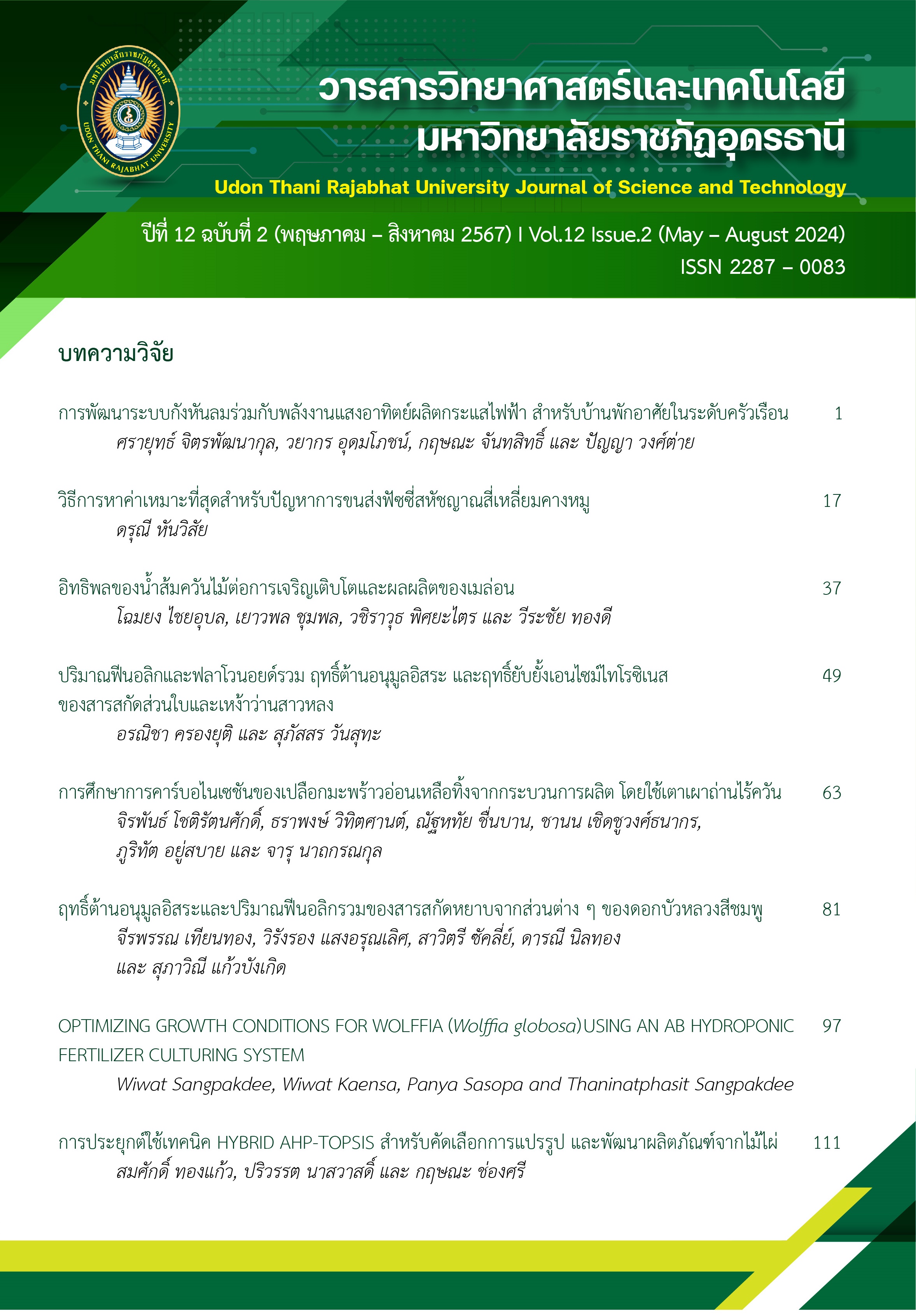OPTIMIZING GROWTH CONDITIONS FOR WOLFFIA (Wolffia globosa) USING AN AB HYDROPONIC FERTILIZER CULTURING SYSTEM
Main Article Content
บทคัดย่อ
This research focuses on the optimization of growth conditions for Wolffia, the smallest flowering plant, utilizing an AB hydroponic fertilizer culturing system. The study addresses the increasing global demand for sustainable and nutritious food sources, positioning Wolffia as a promising solution due to its rapid growth and high protein content. The research methodology involves a systematic investigation into the effects of varying nutrient concentrations, light intensities, and pH levels within the AB hydroponic system. The results highlighted the significance of AB fertilizer concentrations, with 5 ml/l demonstrating superior growth rates and quality metrics. Surprisingly, lower light intensities (3,000-6,000 lux) yielded the highest growth rates and thallus size, challenging conventional expectations. pH levels exhibit a non-significant impact on growth, emphasizing the adaptability of Wolffia to a broader pH range. Controlled environmental conditions further validate the success of the optimized hydroponic system. Proximate analysis reveals Wolffia's nutritional richness, supporting its potential as a functional food source. This research contributes valuable insights to hydroponics and sustainable agriculture, positioning Wolffia as a resilient and resource-efficient food source. The findings have implications for global food security and potential applications in space agriculture.
Article Details
เอกสารอ้างอิง
Delgado-González, C. R., Madariaga-Navarrete, A., Fernández-Cortés, J. M., Islas-Pelcastre, M., Oza, G., Iqbal, H. M., & Sharma, A. (2021). Advances and applications of water phytoremediation: A potential biotechnological approach for the treatment of heavy metals from contaminated water. International Journal of Environmental Research and Public Health, 18(10), 5215. doi: 10.3390/ijerph18105215.
Kaplan, A., Zelicha, H., Tsaban, G., Meir, A. Y., Rinott, E., Kovsan, J., ... & Shai, I. (2019). Protein bioavailability of Wolffia globosa duckweed, a novel aquatic plant–a randomized controlled trial. Clinical Nutrition, 38(6), 2576-2582. doi: 10.1016/j.clnu.2018.12.009.
Monthakantirat, O., Chulikhit, Y., Maneenet, J., Khamphukdee, C., Chotritthirong, Y., Limsakul, S., ... & Daodee, S. (2022). Total active compounds and mineral contents in Wolffia globosa. Journal of Chemistry, 2022(1), 9212872. doi: 10.1155/2022/9212872.
On-Nom, N., Promdang, P., Inthachat, W., Kanoongon, P., Sahasakul, Y., Chupeerach, C., ... & Temviriyanukul, P. (2023). Wolffia globosa-Based Nutritious Snack Formulation with High Protein and Dietary Fiber Contents. Foods, 12(14), 2647. doi: 10.3390/foods12142647.
Pandey, A., Verma, R. K., & Mohan, J. (2020). Assessment of Growth and Composition of Aquatic Plant Wolffia globosa (L.). International Journal of Botany Studies, 5(5), 409-414.
Romano, L. E., & Aronne, G. (2021). The world smallest plants (Wolffia Sp.) as potential species for bioregenerative life support systems in space. Plants, 10(9), 1896. doi: 10.3390/PLANTS10091896.
Romano, L. E., van Loon, J. J., Izzo, L. G., Iovane, M., & Aronne, G. (2024). Effects of altered gravity on growth and morphology in Wolffia globosa implications for bioregenerative life support systems and space-based agriculture. Scientific reports, 14(1), 410. doi: 10.1038/s41598-023-49680-3.
Siriwat, W., Ungwiwatkul, S., Unban, K., Laokuldilok, T., Klunklin, W., Tangjaidee, P., ... & Phongthai, S. (2023). Extraction, enzymatic modification, and anti-cancer potential of an alternative plant-based protein from Wolffia globosa. Foods, 12(20), 3815. doi: 10.3390/foods12203815.
Sree, K. S., Bog, M., & Appenroth, K. J. (2016). Taxonomy of duckweeds (Lemnaceae), potential new crop plants. Emirates Journal of Food & Agriculture, 28(5), 291-302. doi: 10.9755/ejfa.2016-01-038.


